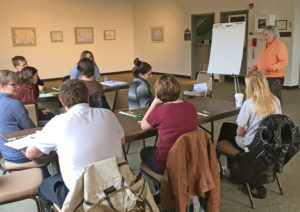Sacred geometry has a long history, including Plato’s Academy (“Let no one enter who is ignorant of geometry.”) and the design of Washington D.C. (see Nicholas Mann’s book) … and several conspiracy theory books and movies. For Floyd artist Carolyn Deck, sacred geometry is a source of inspiration. She discussed this and her Smoyer Gallery exhibit “Ephemeral Equilibrium” with Jan Minton’s HNRS 241 Math and Art class.
Ms. Deck’s webpage at www.csdeck.com describes her progression from an MFA at the Royal College of Art in London to “a paradigm shift to recursive symmetry” in 2012 and a 2014 project titled “Dreams Beyond Numbers – Aperiodic Tilings.” A tiling (or tessellation) is the filling of a space with a set of geometrical shapes, such as rectangular tiles on a floor or a combination of pentagons and hexagons on a soccer ball. This is an active research area for mathematicians, and of interest to crystallographers and other scientists. Sacred geometry makes its appearance through the use of circles to construct regular polygons using compass and straightedge. The students worked through several constructions central to Deck’s current work.
In “Ephemeral Equilibrium” Ms. Deck explores the relationships among tilings, sacred geometry, and nature. A close examination of each of her paintings reveals the geometry underlying the piece. This in turn prompts a reflection on the mathematics underlying all of life, creating a uniquely liberal arts approach to mathematics.













